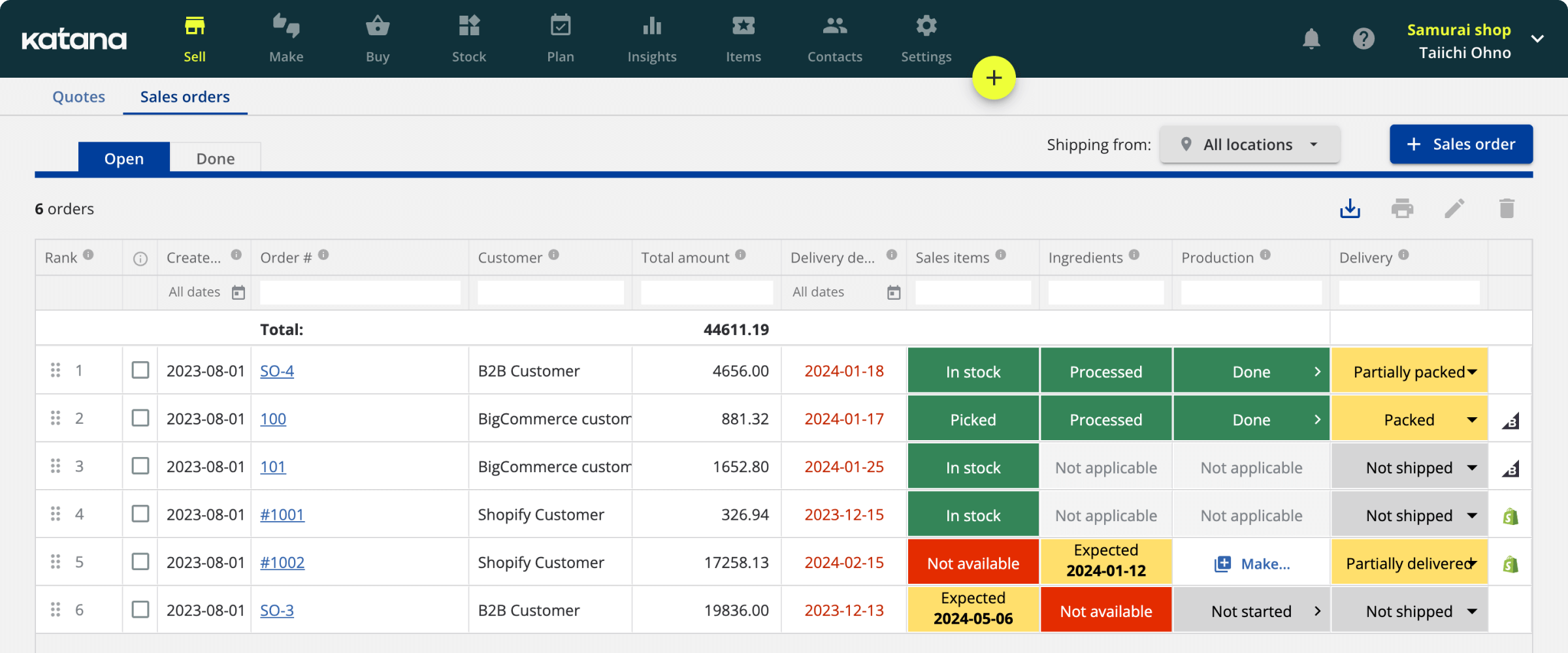Say goodbye to stockouts with automated inventory management
Automated inventory management systems can stop stockouts from occurring without you breaking a sweat. Here are 8 features you need to keep an eye open for when looking for your own systems.

Henry Kivimaa

Picture a scene: you’re running a small artisan bakery that you inherited from your father. It’s in a quaint village, but the locals love the place and frequent it often daily. Still, you get maybe 70 visitors per day. Every time you make a sale, you need to write down the items, subtract them from your inventory, check the remaining inventory to ensure you have enough for the coming days, set up new orders if the stock is running low, and likely a few more steps we didn’t mention.
Doing all that manually is clearly going to be very time-consuming, error-prone, and can lead to inaccurate data. But what if your father didn’t leave you such a picturesque establishment? Perhaps you have to deal with busy customers whose anger level seems to be hovering constantly around 90. They probably won’t be as understanding if there’s an issue due to a human error or if the wait time is a bit longer as you need to manually fill out all the necessary information.
This article is all about leveraging automated inventory management to ensure you, too, can relax a bit while still fulfilling your customers’ orders efficiently and on time.

Where manual inventory management goes wrong
With manual inventory management, businesses have to rely on employees to keep track of their:
- Stock levels
- Related sales
- Financial data
- Supply chain activity
Many companies still keep track of all that with Excel spreadsheets. This means that employees have to periodically count all their stock and then update the values on the spreadsheet. What’s more, employees have to manually input data about what’s been sold and what needs to be restocked.
Inaccurate stock levels
The main downside of this system is that it’s error-prone — it’s all based on manual input, and there’s a greater chance of human error.
This problem is further magnified if the business deals with multiple sales channels since each channel will likely have its own system for tracking inventory. So, if an employee makes a mistake when inputting data into one system, it can also cause problems with the other systems.
These small mistakes inevitably lead to inaccurate inventory levels, leading to stockouts and lost sales. When inventory data isn’t accurately represented, it causes a domino effect of inefficiencies throughout the business and can result in costly mistakes.
Lost sales
If you’ve ever ordered something to get an email two days later saying it’s out of stock, you know how frustrating this can be. Most likely, that was the last time you shopped with that company, which means that the business lost a sale and a customer.
Increased carrying costs
At the other end of stockouts is excess inventory. Ordering more than needed due to incorrect stock levels can increase carrying costs and hurt your bottom line.
Wasted time
Manual stock management is also very time-consuming.
Employees have to spend time inputting data and cross-referencing it to ensure its accuracy. This system is also reactive rather than proactive — businesses only find out about stock levels when they run out of something or do a new stocktake. Luckily, automated inventory management software can streamline these tasks and reduce human errors. Let’s take a look at what it is and how it works.

What is an automated inventory management system?
An automated inventory management system is a tool that helps businesses keep track of their stock levels automatically with minimal human intervention.
It’s a proactive system that can help businesses avoid:
- Stockouts
- Excess inventory
- Lost sales
- Frustrated customers
This is done by using inventory management software that tracks stock levels in real time across all sales channels. This means that businesses always have an accurate picture of their stock levels and can make informed decisions about restocking.
Download the ultimate guide to inventory management
A comprehensive ebook with everything you need to know about inventory management.
7 advantages of inventory automation
While using spreadsheets is free, there are hidden costs involved. These hidden costs quickly add up and soon outweigh the benefits of using a free system. Certain micro businesses may be able to get their stock managed manually, but growing companies will quickly start to feel the strain. This is when inventory automation starts making sense.
There are many benefits when automating your inventory management. Let’s take a look at the 7 most impactful ones.
1. Increased accuracy
One of the biggest benefits of an automated inventory system is that it improves accuracy.
This is because businesses no longer have to rely on manual input. Instead of manual data entry by workers, automated inventory management software offers real-time tracking across all inventory locations and sales channels and automatically updates information.
2. Improved efficiency
An automated inventory control system is much more efficient than manual methods.
Since employees no longer need to fix spreadsheets, they have more time to focus on other tasks. And with a system keeping track of inventory levels, stocktakes don’t need to be done as frequently.
3. Improved decision-making
Accurate inventory data lets you make informed decisions about reordering.
This helps to avoid stockouts and ensures that there is enough inventory to fulfill every order. Moreover, you can also set reorder points with inventory control software. So, when inventory reaches a certain level, you will be notified and can restock before you run out of products.
4. Reduced costs
Keeping stock levels optimal can save a lot on warehousing carrying costs. Businesses only need to hold enough stock to meet customer demand rather than overstocking, which can tie up valuable capital.
5. Improved customer satisfaction
Accurate inventory data helps you maintain inventory levels based on fluctuating demand. As a result, businesses can significantly improve lead time and fulfill orders as soon as possible. This leads to happy customers who are more likely to return and shop again.
6. Simplified scaling
As businesses grow, their inventory requirements will change.
With an automated system in place, it’s easy to make changes and ensure that the system can still cope with the demands of a growing business.
7. Greater visibility
Automated inventory management provides businesses with complete visibility of their stock levels. This means you can see what’s selling well and what’s not and make informed decisions about where to allocate your resources.
Automating these error-prone laborious tasks can free up your time and your employees’ time and increase accuracy and efficiency throughout the entire product lifecycle.
Getting the insights you need when you need them is the key to staying profitable in an increasingly competitive marketplace.

8 key features to look for in automated inventory software
The benefits of automated inventory systems are numerous. But before you start deleting all your Excel spreadsheets, let’s see some of the more important features you should look out for when choosing the best inventory management automation software for your company.
1. Track multiple warehouses
If you have multiple warehouses to manage, then you need software that can keep track of them all in one place. This way, you can see at a glance which warehouse has the products you need and can make informed decisions about where to source them from.
2. Scan barcodes
If you want to speed up the inventory management process, then barcode scanners are a must. This means you can just scan the items as they come into the warehouse, and your enterprise inventory management software will update the stock levels automatically.
3. Set reorder points
As we mentioned before, setting reorder points is a great way to avoid stockouts. Look for software that allows you to set notifications for each item so you can restock before you run out.
4. Seamlessly integrate with other apps
Most likely, you’re already using certain apps to run your business. These may include:
- Accounting tools
- E-commerce platforms
- CRM software
- Shipping providers
It’s important to choose inventory management software that can integrate with these.
Look for automation software that helps you manage all business operations. Implementing process automation helps you integrate your favorite tools to centralize your entire business into one platform.
5. Forecast your inventory
Some inventory management software comes with inventory planning and forecasting features. This can greatly streamline your demand planning while making it a lot more accurate as it’s based on precise sales data.
6. Report and analyze
Reporting is often overlooked, but data analytics is essential for effective inventory management. Look for a platform that offers proper reporting tools that give you invaluable insights regarding your:
- Sales
- Cost
- Inventory
- Production operations
7. Allow access for multiple users
Depending on the size of your business, you may need software that supports multiple users. Even if this is something you currently don’t need, it may become an important feature as your business grows. It should also include user permission, allowing you to limit access if not necessary for work.
8. Synchronize across multiple sales channels
A point of sale (POS) system allows you to track inventory at physical locations and connect with data from online sales. If you have a multichannel sales strategy, then you need POS systems that can keep track of them all. This way, you can avoid selling the same product twice and avoid stockouts.
As you can see, this list can get pretty long, but it’s important to have a clear idea of your requirements before you start looking for the right platform. Once you know what features you need, you can narrow down your options and find the perfect solution for your business.
Automated inventory management with Katana
Katana’s cloud inventory platform equips you with all the tools you need to automate your entire workflow, from purchases to production, to sales and beyond.
Finding the right inventory systems for your business
Once you’ve laid out the needs of your business while also considering future growth, you can start shopping around for the best platform. Luckily, you don’t have to look too hard. Katana covers all the features you need for effective inventory management — offering:
- Barcode scanning
- Reorder points
- Integration with your other business apps
- Forecasting tools
- Reporting
- And much more
Katana is constantly evolving with new features, so you can be sure it will keep up with your business’ current and future needs.
It also provides seamless integration with the most popular applications from e-commerce, accounting, CRM, and more. In addition, there’s an open API, meaning that you can set up your own integrations and custom workflows. What’s more, being cloud-based platform, you can access it from anywhere, and with its affordable subscription plans, you don’t have to break the bank to get started.
If you’re looking for a comprehensive, user-friendly, and affordable inventory management solution, then Katana is definitely worth considering. Book a demo today and see for yourself.

Henry Kivimaa
Table of contents
Get inventory trends, news, and tips every month
Get visibility over your sales and stock
Wave goodbye to uncertainty by using Katana Cloud Inventory for total inventory control
